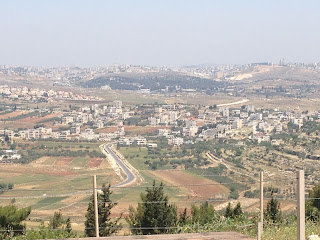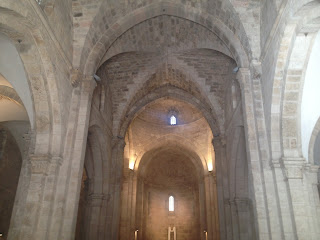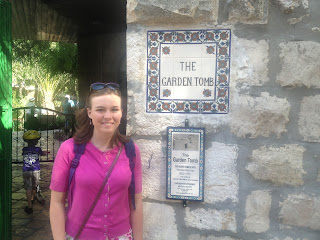The next place that we went was a place called Nabi-Samwil. It is a place that commemorates the prophet Samuel from the Old Testament. It is not anywhere near where they think that Samuel actually lived, but the place was originally misidentified as that so it stuck, and a monument was built to him. The hill it is built upon is nicknamed the "Hill of Joy" because it was where the crusaders came into Jerusalem from. They could get their first view of the city from that hill, and it was tradition to get off of their horses and walk the rest of the way to Jerusalem. So later on a church was built there to accommodate pilgrims that were coming to Jerusalem. It is a very small church. Down in the basement, people go to worship, and there is an empty coffin to commemorate the life of the prophet Samuel. There was only room for about seven people to be down there though. So it took a long time for all of us to go through and look at it. It is also one of the few places that Jews and Muslims worship together because the place had also been turned into a mosque at one point. After going inside, we went to the north side of the church, and looked out at the hill that Gibeah used to be on. That is where Saul ruled from before David and Solomon ruled in Jerusalem. We read about Gibeah in 1 Kings 3 and talked about Solomon asking for understanding there. It was really neat to read that story in the place where it happened because it just made the story seem so much more real. I feel as if the scriptures are coming to life to me here. There is something special about being in the place where something has happened. It makes the experience that much more real to you.
Yesterday, I went out with some friends, and we visited the Pools of Bethesda. There were only ruins there, and it honestly didn't look anything like I thought it would. There were three remaining pools there that were kind of hard to identify. There were originally five pools, but two of them are gone now. (In John 5, it says that there were five porches to the pools, but I'm not really sure what that means after having gone there, and I couldn't read any of the signs because they were all in French because the area is owned by the French church of St. Anne. (The mother of the virgin Mary.) While we there, we also visited St. Anne’s
church that is right next to where the site of the pools is. While walking around the church, I noticed a
statue of a woman that had her arm around a little girl. This was to represent St. Anne and the little
virgin Mary. I have never really thought
about Mary’s parents before. But since I
had been preparing a sacrament meeting talk and thinking about mothers for mothers' day that I gave today, I stood there for a
minute and thought about what kind of mother Mary must have had that prepared
her to bear the Savior of the world. I’m
sure that Mary’s mother was a mother that knew.
I’m sure she taught Mary through an example of righteousness and that
she taught Mary to be steadfast and immovable in always doing what was
right. It was neat to stand there and feel the Spirit of the church that honored a really good mother.
I don't have any pictures of this because you aren't allowed to take pictures of it, but we all went to the Western Wall last night when the Jews were bringing in the Sabbath. First, I should explain that the Western Wall is all that is remaining of Herod's temple that was destroyed after the time of Christ. It is the outer wall of the outer courtyard of the temple, not the actual wall of the temple. It is sometimes known as the Wailing Wall because when the Jews were kicked out of Jerusalem, they would face that wall from wherever they were and mourn that they could not go into their beloved city of Jerusalem. No one calls it the Wailing Wall anymore though because the Jews now are back in Jerusalem. It was probably one of the coolest experiences I have had here yet. You walk to the Western Wall through the gate on the west side of the Old City. You have to go through security to get in there. Also, men and women separate and go to different sides of the wall. But before you get to the wall, there is a large courtyard area where lots of people were singing songs in Hebrew and dancing. It was a really joyful site to see. They were so excited about the Sabbath coming in. I learned a really good lesson. I should treat the Sabbath with more respect, and I want to be as excited about the Sabbath coming as the Jews were about their Sabbath. Me and a few of the friends that I was with joined in one of the circles singing and dancing because we knew a couple of songs that they were singing from our Hebrew class. It was really fun to join in their excitement and experience something really different. I also walked up to the Western Wall and touched it. There was such a contrast between the courtyard area and up close to the wall. There were so many people worshiping and praying that it was hard to get up close to the wall. But it was neat because when I went up and touched the wall, I could feel that this was a special place and that it really had been a part of the temple at one time. The air felt heavy with prayers, and the wall was worn smooth by all of the people over the last two millenniums touching it and praying there. There were also a ton of notes with prayers stuffed into the wall that people had put in there. It was really neat to see that much devotion in those people. While I was there, I realized how grateful I was that I have a real temple to go to and that those blessings are not closed off to me. I also thought that it was neat that the Jewish people are kind of fulfilling their responsibility of the tribe of Judah to gather together in Jerusalem. I think that's why there is such a special spirit at the Western Wall. It was a really neat experience, and I'm thankful that I got to have it.
Today, I gave a talk in church on mothers and women in honor of Mothers' Day. It was really neat to speak here in Jerusalem and look out over the congregation and see all the diversity of the branch here. (Most of the branch is students and faculty that live in the Center, but there are also some other people that have come here that joined the church somewhere else.) Anyway, it was really neat, and everyone told me I did a good job on my talk.
Today, we all went together as a group to the Garden Tomb where it is believed that Jesus was resurrected. I didn't realize it, but Golgotha is right next to it. The "hill" that everyone talks about Christ being crucified on has been built over with Muslim graves. Interesting right? And the tour guides there told us that Christ was actually probably not crucified on the hill, but actually by the road that ran right next to it because that was Roman tradition to put signs above those being crucified for their crime. These signs had to be read, so they didn't put the people on the hill to crucify them. They put them by the roadside so that everyone could see what they had done wrong. After looking at Golgotha, we went and looked at the tomb. There was a beautiful garden that surrounded the place. The tomb was unearthed in the 1860s when the man that owned the land was trying to dig down to do something. (Can't remember what exactly). But it had been covered up for a long time. They think it is the actual tomb owned by Joseph of Arimathea because they also unearthed a wine press next to the tomb that would mean that there was a "garden" of grapes right next to the tomb. The scriptures just tell us that the tomb was surrounded by a garden, but it doesn't specify what was in the garden. Anyway, it was really neat to go look inside the tomb. It was a lot smaller than I thought it would be, but it was neat to be there and to feel the Spirit testify of the resurrection. We sang some hymns as a group, such as "He is Risen," "Christ the Lord is Risen Today," and "I Believe in Christ." It was really neat because a lot of people that were also there stopped and listened to us and took pictures. It was neat to set a good example in that way since we can't talk about the church here.
Anyway, that's all I have for this week. Tomorrow we are traveling to the desert south of Jerusalem called the Negev, which means "dry place" in Hebrew. It's going to be hot, but it's going to be great! I'll post the pictures and tell about it next time.
This is a view looking out on Jerusalem that was taken on our field trip on Monday. You can see the Dome of the Rock in the background.
This is the altar in the Augusta Victoria Church. The mosaic art in the church is beautiful!
This is the ceiling in the church. Christ is in the center, and there are four famous crusaders around Christ along with the twelve apostles.
The Ark of the Covenant has been found! It's in the Augusta Victoria church! Just kidding. This is just a model at the back of the church.
This is the view of the inside of church from the balcony on the second floor.
This is the view from the top of the bell tower of the Augusta Victoria church.
This is Nabi-Samwil, where people come to worship and commemorate the prophet Samuel.
Here's a bunch of us at a lookout point. We decided to take a picture because so many of us were wearing similar colored clothing.
Here's the garden next to St. Anne's church next to the pools of Bethesda. Not sure what the statue is for. It was in French, so I couldn't read it.
The statue of St. Anne (Mary's mother) and the virgin Mary as a little girl. Notice all of the prayer candles in front of the statue.
Check out of the vaulted ceilings in the church. There was a group singing in here when we came, and the echo from them singing was amazing!
Ruins from the pools of Bethesda.
More of the ruins of the pools of Bethesda.
From left to right it's Matthew Searle, me, and Eric Dayhuff down in the ruins of the pools of Bethesda.
Me and Sarah Bennett at the ruins. Picture was photo-bombed by Eric Dayhuff.
Underneath the ruins, there is a cistern built by the Romans. It was used to store water, but there is no water in there anymore. It was pretty big.
This is one of the actual pools of Bethesda. There used to be five pools, but only three of the pools are left.
This is the best view I can get of the Al-Aqsa Mosque as a non-Muslim. It is the third holiest site in Islam because it's next to the Dome of the Rock.
This is the place where they think that Christ was crucified. Notice the two caves that looks like eyes. There used to be another cave underneath next to that bus, but it was taken out to accommodate that parking lot. So it looks like skull since Golgotha means "place of a skull."
The garden tomb where it is thought that Christ was resurrected.
Me next to the Garden Tomb.
Inside of the tomb. That's the bench that they think that Christ was laid on. The cross on the wall is a recreation of a cross that was originally painted there by a church that was here during the Byzantine period. (4th-7th Century.)
Part of our group at the Garden Tomb.
The gate to the Garden Tomb.

























Thanks for sharing Rachel! What awesome experiences you are able to have in the Holy Land. Look forward to reading more about your adventure.
ReplyDeleteJonathan